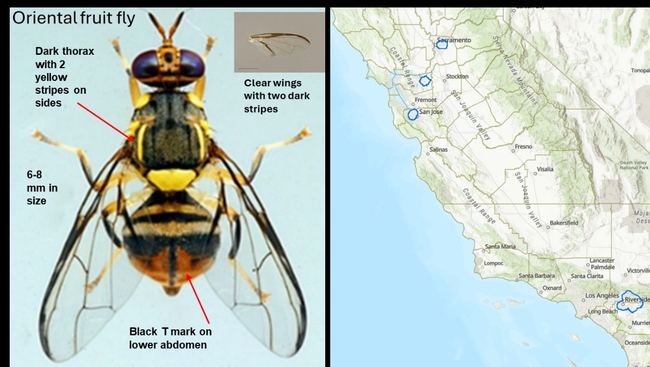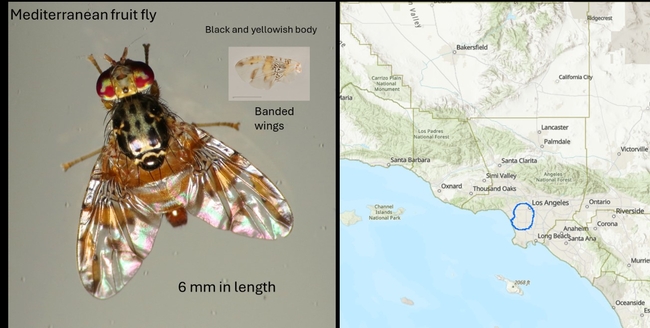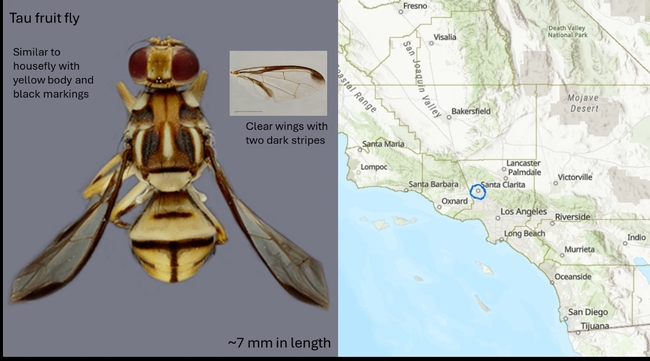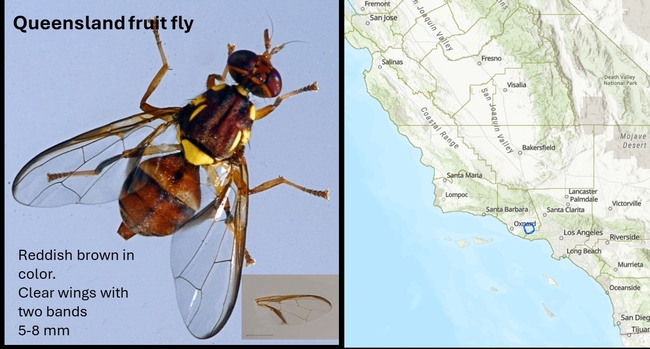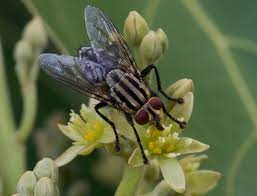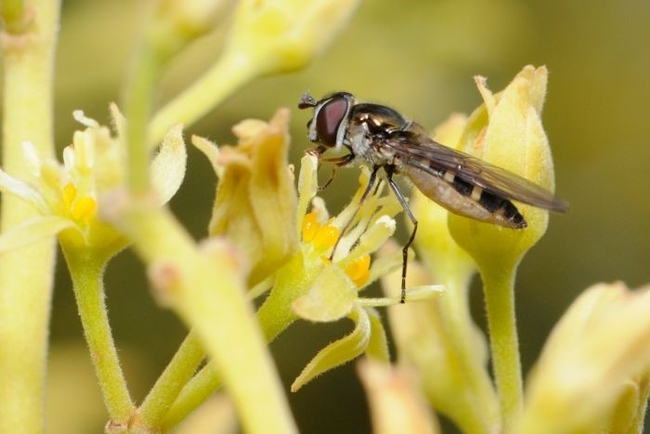
Posts Tagged: flies
Watch Out for Fruit Flies
California inundated with invasive fruit flies
Bodil Cass
Extension Subtropics Entomologist, Dept of Entomology, UCR
California is experiencing an unusually high number of invasive fruit fly infestations. There are seven active regional quarantines in different areas of the state for four different species of exotic fruit flies in the family Tephritidae: Medfly (Ceratitis capitata) and Tau fly (Zeugodacus tau) in Los Angeles, Queensland fruit fly (Bactrocera tryoni) at the border of Ventura/Los Angeles, and four separate quarantine areas for the Oriental fruit fly (‘OFF'; B. dorsalis) in Riverside/San Bernardino, Contra Costa, Sacramento, and Santa Clara counties. A quarantine just ended following the successful eradication of an infestation of Mexfly (Anastrepha ludens) in San Diego County.
The OFF infestation in San Bernardino/Riverside is especially serious in terms of the unprecedented number of flies found and the many acres of commercial production affected. For this species, six male flies/one mated female/one larva triggers a quarantine, but here we have detected more than 500 adult flies and are still finding more, even during winter. The affected area, including more than 550 square miles, encompasses not just residential properties but an important agricultural region with commercial farms. Farmers in the area are bringing in more trained pesticide applicators, and facing crop losses, delayed harvests, disruption to integrated pest management practices for other pests, and increased costs as they act to mitigate the damage. The unfortunate proximity of the epicenter of the outbreak to agricultural production is necessitating some problem solving and adaptation of mitigation protocols as we race to stop the fly population from establishing.
The quarantine boundary is also approaching the edge of the California Citrus State Historic Park and the University of California Riverside campus, with fly finds less than two miles from active subtropical fruit and biological control research plots, the Givaudan Citrus Variety Collection, and citrus trees of historical importance. Researchers are gauging how the infestation and mitigation protocols might impact current experiments being conducted, including delayed harvest dates, and scrambling to adapt research plans accordingly.
Usually, we have one or two small exotic fruit fly quarantines per year, so the current situation is a strain on resources statewide. The number of areas invested and the severity of the OFF infestation in San Bernardino/Riverside are stretching resources thin as the Department of Agriculture pulls insect detection specialists and staff from other projects to help place more traps, enact compliance agreements, and visit residential properties. San Bernardino County is providing yard signs to help encourage residents not to move produce while the quarantine is in effect.
Exotic fruit flies are one of the most serious threats to food production in the state, with the estimated economic cost of any one of these Tephritidae species becoming established running into the $100 of millions through crop losses, additional pesticide use, and collapse of export markets. These flies are of concern because the larvae/maggots feed on fresh fruit and vegetables prior to harvest. The immature flies chew through the fresh fruit, and it rots on the tree or vine, or drops prematurely to the ground. Fruit infested with large maggots is not marketable to consumers and not fit for human consumption. They are much more damaging than other flies, like smaller Drosophila species that develop on fruit that has already matured, been harvested and is in compost. Tephritidae flies are also highly polyphagous, with some species attacking more than 100 types of fruit, vegetables, and nuts, including the major food crops produced in the state; citrus, avocado, dates, tomatoes, bell peppers, figs, grapes, cucurbits and many specialty crops are all at risk.
We have a long-standing success record of keeping fruit flies out of the state, and fully expect to achieve eradication of all the current infestations through an approach that consists of biological control (mating disruption by sterile insect release), chemical control (targeted pesticide baits), and physical control (destruction of infested fruit from the current season and restrictions on movement of fruit from infested areas). If you have questions about a fruit fly quarantine/eradication, or if you think you have fruits and vegetables infested with fruit fly larvae, call the CDFA Exotic Pest Hotline at 1 (800) 491-1899, contact your local Agricultural Commissioner, or the University's Cooperative Extension. More information specifically for growers is available at regional Farm Bureau meetings and on the CDFA website: https://www.cdfa.ca.gov/plant/PE/InteriorExclusion/current_grower_info.html#INTRO
Image of Oriental Fruit Fly
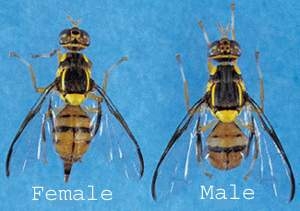
oriental fruit fly image
Staying Up to Date on Fruit Flies
Invasive Fruit Flies
California is currently experiencing an unusually high?number?of invasive fruit fly?detections, resulting in quarantines being established across numerous California counties, including Ventura County. These invasive fruit fly species – including Mediterranean fruit fly, Oriental fruit fly, Queensland fruit fly and tau fruit fly – are considered not established in California. The California Department of Food and Agriculture (CDFA), in cooperation with the United States Department of Agriculture (USDA) and various County Agricultural Commissioners, has initiated local regulatory measures to eradicate and prevent the further spread of these fruit fly species statewide.
Resources:
- CAFruitFly.com
- Invasive Fruit Fly - Guide for Growers [NEW]
- Fruit Fly Quarantine Boundaries and Maps
- Frequently Asked Questions from Industry Members
- Harvest and Crop Movement Requirements for Growers
- Oriental Fruit Fly (Over 300 crops impacted)
- Mediterranean Fruit Fly
- Queensland Fruit Fly
- Tau Fruit Fly
- Residential Treatment Information and Maps (Conducted by CDFA)
While CDFA, USDA and our local County Agricultural Commissioners will be working to educate residents on the issue in the various quarantine areas, we ask you to please encourage nearby residents to avoid moving any homegrown produce from their properties and to cooperate with agriculture officials working in their area.
CDFA Photo: Oriental Fruit Flies

oriental fruit fly five sisters
Fruit Flies
Invasive Fruit Fly Quarantine
What to know as a SJV citrus grower?
Sandipa Gautam
Area Citrus IPM Advisor
UC Statewide IPM Program Operations
Several species of invasive fruit flies that belong to the family Tephritidae are considered serious pests of hundreds of agricultural crops including citrus. These flies lay eggs on or near the fruit surface, and when the maggots hatch, they bore into the fruit, making it unfit for human consumption and causing major losses to fruits and vegetable production. California is experiencing an unusually high number of invasive fruit fly detections in the 2023/24 season and several areas in California are now under a fruit fly quarantine. For many invasive fruit fly species, quarantine is triggered when two or more adult flies are caught in a trap or by a single detection of larvae or pupae indicating a breeding population. Core area is 0.5-mile radius around the detection site and a quarantine area is 4.5-mile radius around each detection.
Counties Currently Impacted by Invasive Fruit Fly Quarantines:
- Oriental fruit fly: Contra Costa, Riverside, Sacramento, San Bernardino, and Santa Clara Counties (Figure 1)
- Mediterranean fruit fly: Los Angeles County (Figure 2)
- Tau fruit fly: Los Angeles County (Figure 3)
- Queensland fruit fly: Los Angeles and Ventura Counties (Figure 4)
Why is fruit fly quarantine concerning to citrus growers?
Citrus is a known host to all invasive fruit fly species. Fruit fly life cycle begins as eggs laid by adult female on surface or under the fruit rind maggots hatch and bore into the fruit and develop inside the fruit (Figure 5). They drop to the ground and pupate. Many fruit fly species are known to overwinter as prepupae or pupae, but some species like Medfly can overwinter in all life stages inside fruit or as pupae on the ground. Adults emerge in early spring and the life cycle continues. Because eggs and immatures can be present inside the fruit, movement of infested fruit may accidentally transport them to a new area where fruit fly has not been detected.
Invasive fruit flies – what to look for?
Four species of fruit flies are currently regulated in California. The adults may look similar to houseflies but are distinctly different in color and the markings on the body. They are about 5-8 mm in size, much bigger than spotted wing drosophila, another invasive species that has been established in California.
- Oriental fruit fly: ~8 mm size, bright yellow colored body with a dark T shaped mark on the abdomen (Figure 1).
- Mediterranean fruit fly (Medfly): ~5-6 mm in size, yellow-light brown body, clear wings with brown bands (Figure 2)
- Tau fruit fly: ~7 mm in size, yellow body with black markings (Figure 3)
- Queensland fruit fly: ~5-8 mm in size, wasp-like body, reddish brown in color with distinct yellow markings, clear wings with band along the top margin.
Figure 1. Oriental fruit fly adult with identifying characters (left) and areas in California under quarantine as of January 2024: Contra Costa, Riverside, Sacramento, San Bernardino, and Santa Clara Counties (right).
Figure 2. Mediterranean fruit fly adult with identifying characters (left) and areas in California under quarantine as of January 2024 – Los Angeles County (right).
Figure 3. Tau fruit fly adult with identifying characters (left) and areas in California under quarantine as of January 2024: Los Angeles County (right).
Figure 4. Queensland fruit fly adult with identifying characters (left) and areas in California under quarantine as of January 2024: Ventura County (right).
You can find more information about invasive fruit fly species including interactive quarantine maps, regulatory information and pest profile information below: https://www.cdfa.ca.gov/plant/PDEP/treatment/index.html
Figure 5. Fruit fly larvae are white, legless maggots. They bore into the fruit and feed on pulp. Infested fruit may drop and decay.
What is happening to prevent fruit fly spread?
The California Department of Food and Agriculture (CDFA), in cooperation with the United States Department of Agriculture (USDA) and County Agricultural Commissioners, has initiated local regulatory measures to eradicate and prevent the statewide spread of Queensland fruit fly, Tau fruit fly, Mediterranean fruit fly and Oriental fruit fly. California Citrus Quality Council (CCQC) in coordination with researchers is developing a systems approach that allows for post-harvest treatment of citrus fruit for movement from the core to pack.
What can you do?
- If you are a grower inside the quarantine area, follow regulations about harvesting, processing, or storing fruit. Contact your County Ag Commissioner about the latest regulations, or review FAQs here: https://www.cdfa.ca.gov/plant/fruitfly/docs/Invasive_Fruit_Fly_FAQ_Industry_1-18-24.pdf . If your property is under fruit fly quarantine, follow either pre or postharvest treatment protocols from USDA to move fresh fruit
- Grower outside the quarantine area, stay informed, invest in trapping and pre-quarantine treatments to avoid potential harvest delays should a quarantine be established in the future. For information on prevention and exclusion visit: https://www.cdfa.ca.gov/plant/PE/InteriorExclusion/current_preharvest_treatment.html
- Quarantines boundaries can change rapidly, so it is critical to stay in communication with your local agricultural commissioner.
- Report any suspected invasive fruit fly sightings to CDFA, USDA or your local County Agricultural Commissioner.
- Encourage neighbors, friends, and family to avoid moving any homegrown produce from their properties and to cooperate with agriculture officials working in their area.
- Help spread the “Don't Pack a Pest” message to travelers or those receiving produce in the mail or through other shipping channels.
- Share social media posts created or shared by CDFA, USDA or County Agricultural Commissioners.
Flies in My Avocados
There are all kinds of pollinators in an avocado orchard, not just honeybees. In fact, there is a whole range of native bees that also pollinate the trees. There are nearly 1,600 native bee species in California, and over 30 have been identified in avocado orchards in Ventura County alone .
Another pollinator group is comprised of the Diptera order – flies. This order includes hoverflies and houseflies. Flies can be better at cross-pollinating avocado than honeybees because they move randomly through an orchard between different cultivars, visiting male and female flowers. The effectiveness of flies as pollinators varies between species, but there can often be more than 20 types in an orchard. This means it is likely that some good pollinators will be present, and that pollination can occur whenever the female flowers are open.
In the aforementioned Ventura avocado study, hoverflies are the most common flower visitor.
Housefly
Hoverfly
Avocado Growers, Dont Overlook Flies
Rae Olsson rachel.olsson@wsu.edu 509-335-4846
PULLMAN, Wash. - A tiny bee imposter, the syrphid fly, may be a big help to some gardens and farms, new research from Washington State University shows.
An observational study in Western Washington found that out of more than 2,400 pollinator visits to flowers at urban and rural farms about 35% of were made by flies--most of which were the black-and-yellow-striped syrphid flies, also called hover flies. For a few plants, including peas, kale and lilies, flies were the only pollinators observed. Overall, bees were still the most common, accounting for about 61% of floral visits, but the rest were made by other insects and spiders.
"We found that there really were a dramatic number of pollinators visiting flowers that were not bees," said Rae Olsson, a WSU post-doctoral fellow and lead author of the study published in Food Webs. "The majority of the non-bee pollinators were flies, and most of those were syrphid flies which is a group that commonly mimics bees."
Syrphid flies' bee-like colors probably help them avoid predators who are afraid of getting stung, but they are true flies with two wings as opposed to bees which have four. The flies might have additional benefits for plants, Olsson added, since as juveniles they eat pests like aphids. As adults, they consume nectar and visit flowers so have the potential to move pollen the same way that bees do, though it is less intentional than bees who collect pollen to feed their young.
For the study, the researchers surveyed plants and pollinating insects and spiders on 19 rural farms and 17 urban farms and gardens along the Interstate 5 corridor in Western Washington. They conducted surveys six separate times over two years. In addition to the visits by bees and syrphid flies, they also catalogued more rare visits by other arthropods including wasps, lacewings, spiders, butterflies, dragonflies, beetles and ants--all with visits of less than 4%.
Olsson first noticed the many different non-bee pollinators while working on a bee-survey project led by Elias Bloom, a recent WSU doctoral graduate. The results of this study underscore the need for researchers as well as gardeners and farmers to pay more attention to alternative pollinators, Olsson said, and hoped that similar studies would be conducted in other regions of the country.
"Bee populations are declining, and we are trying to help them, but there's room at the table for all the pollinators," Olsson said. "There are a lot of conservation and monitoring efforts for bees, but that doesn't extend to some of the other pollinators. I think people will be surprised to find that there are a lot more different types of pollinating insects - all we really need to do is to start paying a little more attention to them."
The study also noted pollinator differences between rural and urban spaces. Observations sites in urban areas showed a greater diversity of pollinators corresponding with the wider range of plants grown in city gardens and smaller-sized farms. Rural farms with their larger fields of plants had a greater abundance.
For every grower, urban or rural, who is interested in increasing the number and diversity of pollinators visiting their fields or gardens, Olsson recommended increasing the variety of flowering plants.
Making sure that something is flowering all throughout the season, even if on the edge of a field, will support the biodiversity of pollinators because their different life stages happen at different times of the year.
"Some pollinators like certain butterflies and moths are only present in a pollinating form for a small period of time," Olsson said. "They may only live for a few days as adults, so when they emerge and are ready to pollinate, it's good to make sure that you have something for them to eat."
Read On: https://news.wsu.edu/2021/06/22/bee-impersonating-flies-show-pollinator-potential/
Photo: Not a bee, a hover fly or syrphid fly

syrphid adult

